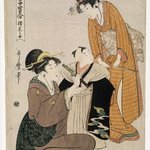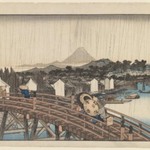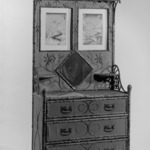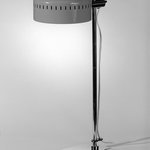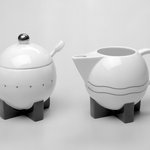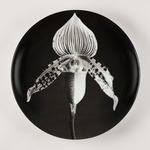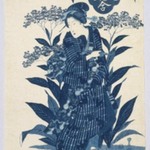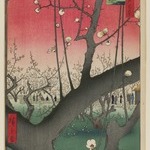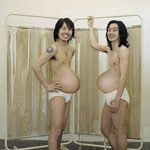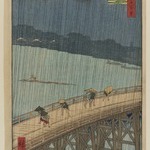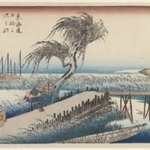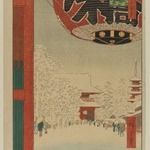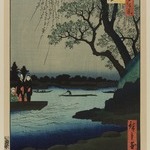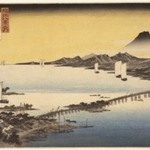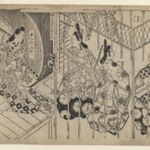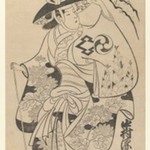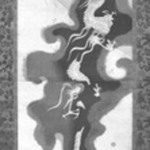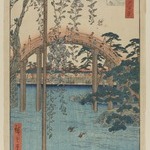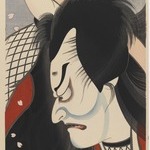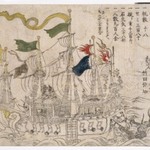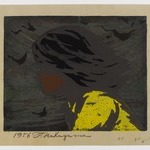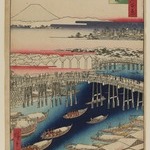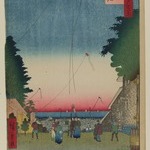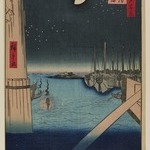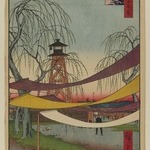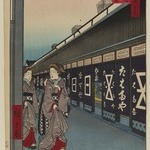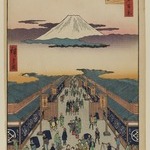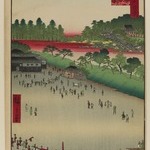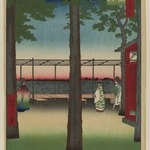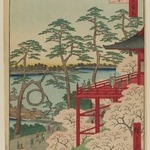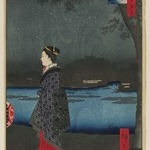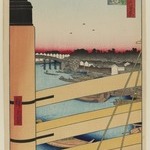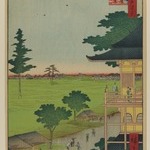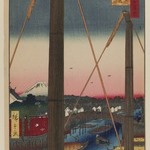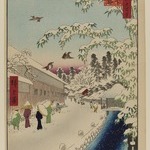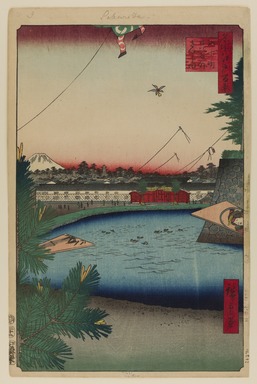
Hibiya and Soto-Sakurada From Yamashita-Cho, No. 3 in One Hundred Famous Views of Edo
Utagawa Hiroshige
Asian Art
In this view looking westward from a commoner neighborhood (Yamashita-chō) toward the daimyo, or military lord, district of Soto-Sakurada, Hiroshige represents children's games and activities associated with the New Year’s holiday. Projecting discreetly from either side—the one on the left from behind a close detail of the New Year's kadomatsu, or gate pine—are paddles for a game similar to badminton with the shuttlecock posed in midair. In the distance, kites dance whimsically against the upper margin.
MEDIUM
Woodblock print
DATES
12th month of 1857
PERIOD
Edo Period, Ansei Era
DIMENSIONS
Image: 13 1/4 x 8 5/8 in. (33.7 x 21.9 cm)
Sheet: 14 3/8 x 9 3/16 in. (36.5 x 23.3 cm) (show scale)



MARKINGS
publisher: Shitaya Uo Ei
SIGNATURE
Hiroshige-ga
COLLECTIONS
Asian Art
ACCESSION NUMBER
30.1478.3
CREDIT LINE
Gift of Anna Ferris
PROVENANCE
Prior to 1930, provenance not yet documented; by 1930, acquired by Anna Ferris of Summit, NJ; 1930, gift of Anna Ferris to the Brooklyn Museum.
Provenance FAQ
CATALOGUE DESCRIPTION
This print is an example of the compositional wit that characterizes many of the "One Hundred Famous Views of Edo," involving a superimposition of an extreme close-up on a distant landscape. The spirit of New Year play is expressed by the kites in the sky. One is a yakko figure dancing in the upper margin; another is haplessly fallen on a rival's string. Two close-up battledores (hagoita) shown from either side, the one on the left has an even closer detail of a Kadomatsu pine (compare with pl. 2). In midair above the shuttlecock appears to be moving right to left. The location here is exactly reversed from the previous print. Here it is looking from a commoners' neighborhood (Yamashita-cho), now the area around Soto-Sakurada. The impressive facade that stretches along the far side of the moat is one of the most detailed depictions of a daimyo mansion found in any ukiyo-e print, the main residence of the Nabeshima clan of Saga; the elaborate design of the gate denotes a domain of high rank (350,000 koku in this case). This site is now occupied by Hibiya Park, and the one to the left, where the corner wall of the mansion of the lord of Shirakawa is just barely visible behind a pine branch, is now the Imperial Hotel. Overall, the print offers a pleasing contrast between the solemn majesty of the daimyo presence in Edo and the lightness and wit of the commoners' play.
EXHIBITIONS
MUSEUM LOCATION
This item is not on view
CAPTION
Utagawa Hiroshige (Japanese, 1797–1858). Hibiya and Soto-Sakurada From Yamashita-Cho, No. 3 in One Hundred Famous Views of Edo, 12th month of 1857. Woodblock print, Image: 13 1/4 x 8 5/8 in. (33.7 x 21.9 cm). Brooklyn Museum, Gift of Anna Ferris, 30.1478.3 (Photo: Brooklyn Museum, 30.1478.3_PS20.jpg)
IMAGE
overall, 30.1478.3_PS20.jpg. Brooklyn Museum photograph, 2023
"CUR" at the beginning of an image file name means that the image was created by a curatorial staff member. These study images may be digital point-and-shoot photographs, when we don\'t yet have high-quality studio photography, or they may be scans of older negatives, slides, or photographic prints, providing historical documentation of the object.
RIGHTS STATEMENT
No known copyright restrictions
This work may be in the public domain in the United States. Works created by United States and non-United States nationals published prior to 1923 are in the public domain, subject to the terms of any applicable treaty or agreement.
You may download and use Brooklyn Museum images of this work. Please include caption information from this page and credit the Brooklyn Museum. If you need a high resolution file, please fill out our online application form (charges apply).
The Museum does not warrant that the use of this work will not infringe on the rights of third parties, such as artists or artists' heirs holding the rights to the work. It is your responsibility to determine and satisfy copyright or other use restrictions before copying, transmitting, or making other use of protected items beyond that allowed by "fair use," as such term is understood under the United States Copyright Act.
The Brooklyn Museum makes no representations or warranties with respect to the application or terms of any international agreement governing copyright protection in the United States for works created by foreign nationals.
For further information about copyright, we recommend resources at the United States Library of Congress, Cornell University, Copyright and Cultural Institutions: Guidelines for U.S. Libraries, Archives, and Museums, and Copyright Watch.
For more information about the Museum's rights project, including how rights types are assigned, please see our blog posts on copyright.
If you have any information regarding this work and rights to it, please contact copyright@brooklynmuseum.org.
RECORD COMPLETENESS
Not every record you will find here is complete. More information is available for some works than for others, and some entries have been updated more recently. Records are frequently reviewed and revised, and we welcome any additional information you might have.
